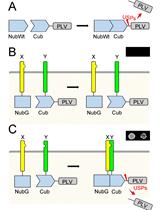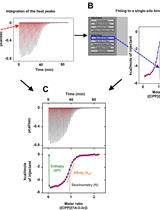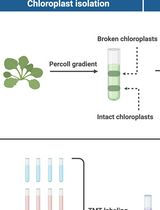- EN - English
- CN - 中文
A Chemiluminescence Based Receptor-ligand Binding Assay Using Peptide Ligands with an Acridinium Ester Label
使用吖啶酯标记的肽段配体进行化学发光的受体配体结合实验
发布: 2015年03月20日第5卷第6期 DOI: 10.21769/BioProtoc.1422 浏览次数: 11603
Abstract
Studying the biochemical interaction of ligands with their corresponding receptors requires highly sensitive detection and monitoring of the bound ligand. Classically, radioactively labelled ligands have been widely used as highly sensitive tools for such binding measurements. Disadvantages of radiolabelling include instability of products, high costs and risks of working with radioactivity. Thus, assays using chemiluminescent probes offer convenient, highly sensitive alternatives. Here we suggest acridinium esters as suitable conjugates to label ligands of interest. Chemical oxidation of acridinium esters triggers chemiluminescence, allowing quantitation of this compound down to amol concentrations in standard luminometers. The first report about acridinium esters in immunoassays date back to 1983 (Weeks et al., 1983) and demonstrated the ability to conjugate acridinium to peptides, followed by using such peptides to measure receptor – peptide ligand interactions (Joss and Towbin, 1994).
Recently, this binding assay was adapted for studying derivatives of the plant peptide IDA (INFLORESCENCE DEFICIENT IN ABSCISSION) and their interaction with the corresponding receptor HSL2 (HAESA-LIKE 2) was reported (Butenko et al., 2014). Here we describe how this sensitive, nonradioactive binding approach can be used to reveal receptor-ligand binding in plant material.
Materials and Reagents
- Plant material harboring the receptor of interest in an immobilized form
Suggested plant materials could be: Intact cells from suspension cultures, ground plant tissue or isolated receptors immobilized on immunoprecipitation beads.
Notes:
- The receptor must be immobilized (on cells, cell debris, IP-beads) in order to allow efficient washing to remove unbound ligand without washing away the receptor molecules.
- Levels of some receptors are exceedingly low. Therefore, overexpression, e.g. by transient expression in Nicotiana benthamiana (N. benthamiana) leaves (Li, 2011), may be required to obtain sufficient binding sites.
- Use a negative control, same material lacking a functional receptor, whenever possible.
- The receptor must be immobilized (on cells, cell debris, IP-beads) in order to allow efficient washing to remove unbound ligand without washing away the receptor molecules.
- MES (2-ethanesulfonic acid)
- NaCl
- DTT
- 33 µl proteinase Inhibitor (Sigma-Aldrich, catalog number: P9599 )
- 5 mM citric acid
- 0.03 % H2O2 in 100 mM NaOH (prepare fresh from a 30% H2O2 stock)
- Appropriate binding buffer (see Recipes)
Equipment
- Mortar and pestle
- Table top centrifuge
- Luminometer (e.g. single tube machines like FB 12, Berthold technologies, that allows injection)
- Acridinium-labeled peptide
Important: The modified peptide should be tested for biological activity in your usually used bio-assay of choice and should not deviate much from the activity of the unmodified peptide.
- Unlabeled peptide (synthetic unlabeled peptides can be ordered by e.g. Biomatik)
- Peptides and conjugation with acridinium
Note: Peptides can be ordered (on resin) from a company of choice or synthesized using solid-phase technology with Fmoc-protected amino acids. Acridinium esters can be conjugated to the N-terminal amino groups of the peptides on resin by coupling with N-hydroxysuccinimide activated acridinium esters (Cayman) before deprotection and purification of the peptides via HPLC.
Procedure
文章信息
版权信息
© 2015 The Authors; exclusive licensee Bio-protocol LLC.
如何引用
Wildhagen, M., Butenko, M. A., Aalen, R. B., Felix, G. and Albert, M. (2015). A Chemiluminescence Based Receptor-ligand Binding Assay Using Peptide Ligands with an Acridinium Ester Label. Bio-protocol 5(6): e1422. DOI: 10.21769/BioProtoc.1422.
分类
植物科学 > 植物生物化学 > 蛋白质 > 相互作用
植物科学 > 植物免疫 > 信号感知与传递
生物化学 > 蛋白质 > 相互作用 > 蛋白质-配体相互作用
您对这篇实验方法有问题吗?
在此处发布您的问题,我们将邀请本文作者来回答。同时,我们会将您的问题发布到Bio-protocol Exchange,以便寻求社区成员的帮助。
Share
Bluesky
X
Copy link












